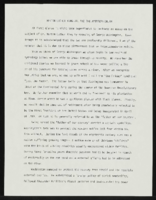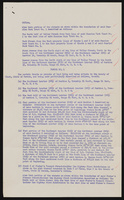Search the Special Collections and Archives Portal
Search Results
Kim Sisters Scrapbooks and Clippings
Identifier
Abstract
The Kim Sisters material date from 1959 to 1966 and 1983. It consists of two scrapbooks and one folder of photocopied materials containing newspaper clippings about the appearances of the Kim Sisters muscial group throughout the United States as well as Italy, Germany, and Spain. It also includes two record album sleeves.
Archival Collection
Dr. Ruben Acherman oral history interview
Identifier
Abstract
Oral history interview with Ruben Acherman conducted by Monserrath Hernandez and Laurents Bañuelos-Benítez on July 18, 2019 for the Latinx Voices of Southern Nevada Oral History Project. In this interview, Acherman discusses growing up in Palmira, Colombia, where his father emigrated to from Romania. He talks about how accepted he felt in a Catholic community, moving to Cali, Colombia to study medicine, and describes completing his rural residency in San Pedro, Colombia. Acherman then recalls specializing in cardiology at the University of Southern California (USC). Later, Acherman explains why he chose to specialize in cardiology, his interests in pediatric cardiology, and his inability to continue studying due to the lack of financial stability and his immigration status. Acherman describes his move to the Summerlin residential community in Las Vegas, Nevada after being offered a position to work for Dr. Bill Evans in 2001, and compares the differences in health care between the United States and Columbia. Lastly, Acherman discusses his first balloon dilation procedure and talks about the illustrations he has created in cardiology textbooks.
Archival Collection
Rabbi Yocheved Mintz Photographs
Identifier
Abstract
The collection is comprised primarily of photographs of Rabbi Yocheved Mintz at different events and programs held at Las Vegas, Nevada synagogue Congregation P'nai Tikvah from 2006 to 2017. The collection includes photographs of congregants during different workshops and events held at the synagogue. The collection also includes photographs of Rabbi Mintz and congregants during holidays (Hannukah, Purim, Rosh Hashanah, and Passover), Jewlicious (Jewish education classes and workshops), and from the congregation newsletter.
Archival Collection
University of Nevada, Las Vegas Student Engagement and Diversity Records
Identifier
Abstract
The Student Engagement and Diversity Records (approximately 1989-2009) document activities related to the University of Nevada, Las Vegas (UNLV) Student Engagement and Diversity office and its predecessors. Materials include documents and photographs about activities and events such as Premier UNLV, Homecoming, Rebels After Dark, and the Rebel Variety Show.
Archival Collection
Margo Mansergh Papers
Identifier
Abstract
The Margo Mansergh Papers (approximately 1920-2010) document the life of former showgirl and dancer Margaret "Margo" Mansergh Tomaszewski. Materials include photographs of Margo modeling, backstage at various shows, portraits, and personal family photographs as well as programs from her international career performing in the Lido de Paris and Pigalle Nightclub in London, as well as a number of shows in Las Vegas, Nevada, such as Vive Les Girls, Casino de Paris, Minsky's Burlesque, and Lido de Paris at the Stardust. The collection contains materials from Mansergh's modeling career, including photographs, book covers, and images of her as an extra in films. Digital images from the closing Stardust performance and an event for Miss Bluebell are also found in the collection.
Archival Collection

Hernando Amaya oral history interview: transcript
Date
Archival Collection
Description
Oral history interview with Hernando Amaya conducted by Laurents Banuelos-Benitez, Marcela Rodriguez-Campo, and Barbara Tabach on October 18, 2018 and December 3, 2018 for the Latinx Voices of Southern Nevada Oral History Project. In this interview, Hernando Amaya talks about his childhood and education in Bogota, Colombia. He discusses his start in journalism as a young man and working for El Espectador, the Colombian national newspaper. He discusses his experiences reporting on the narco-terrorism occurring in Medellin, Colombia and how this eventually led to his immigration to the United States. Amaya moved to Las Vegas, Nevada in 2001 and continued his career in journalism by working for local Spanish speaking papers and websites. He relates his civic involvement in the Las Vegas area, his work as the president of the Colombian Association of Las Vegas, and various other civic engagements. As a journalist, he asserts the importance of knowing one's culture, storytelling, learning history, and being active in the community.
Text

Transcript of interview with George Pollak by Claytee White, May 25, 2010
Date
Archival Collection
Description
George was raised in Mattapan, a suburb of Boston, by his mother and father. George had four siblings and was the second youngest. George shares fond memories of growing up and playing softball and tennis in the neighborhood park with his numerous friends. George could listen to a song on the radio and play it on the piano by ear when he was as young as four years old. George had several jobs to earn money growing up, including working in a record store and as a busboy. Eventually George and his brother joined a trio with Steve Harrington and performed in clubs. In 1958, George joined his brother and Paulette Richards in Las Vegas where they had a contract to play at El Rancho Hotel & Casino where they played until it was destroyed by fire. Following the fire, George and his brother parted ways and each did their own thing. In the 1960s, George began playing with the band at Caesars Palace. George used his background in accounting to do some bookkeeping and payroll for some of the ban
Text

"Martin Luther King, Jr. and the American Dream": article draft by Roosevelt Fitzgerald
Date
Archival Collection
Description
From the Roosevelt Fitzgerald Professional Papers (MS-01082) -- Drafts for the Las Vegas Sentinel Voice file. On George Washington and Martin Luther King, Jr. comparisons.
Text


